
Table of Contents
In Applied Behavior Analysis (ABA) therapy, a Behavior Intervention Plan (BIP) serves as a well-organized approach designed to address and alter problematic behaviors in individuals with autism and developmental conditions. It is a crucial tool in the ABA process, designed to help the individual learn more adaptive and functional behaviors while reducing the occurrence of undesired actions.

The BIP follows the principles of ABA, which rely on data-driven methods to modify behavior. Through systematic observation, assessment, and implementation of evidence-based techniques, ABA professionals create a clear pathway for improving behavior. By using positive reinforcement and teaching new skills, the BIP helps individuals develop alternative, more adaptive behaviors, which can increase their social integration and independence.
5 Key Components of a Behavior Intervention Plan
A well-constructed Behavior Intervention Plan is composed of several essential components that guide its implementation. These include:
Functional Behavior Assessment (FBA)
Before a Behavior Intervention Plan can be created, a comprehensive Functional Behavior Assessment (FBA) must be conducted. The FBA serves as the foundation of the BIP by identifying the root causes or triggers of the problematic behaviors. This assessment typically involves observing the individual in various settings, conducting interviews with caregivers, and reviewing behavioral data to understand when, where, and why the behaviors occur.
The goal of the FBA is to determine the function of the behavior – whether it is attention-seeking, avoidance-related, self-stimulatory, or driven by some other factor. Understanding the underlying reason for the behavior helps in selecting appropriate interventions that address the root cause rather than just the symptoms.
Specific Behavioral Goals
Once the FBA is complete, the next step is to define clear and measurable behavioral goals. These goals are aimed at increasing positive behaviors and decreasing negative ones. They should be specific, achievable, and measurable so that progress can be tracked over time. For instance, a goal might be to increase a child’s ability to ask for help rather than engaging in tantrums when frustrated.
Behavioral goals should be framed in a way that they can be evaluated objectively, often through data collection. For example, a goal like “reduce tantrums in the classroom” might be measured by tracking the number of tantrum episodes over a given period, with the aim of reducing these incidents by a certain percentage.
Intervention Strategies and Techniques
The intervention strategies are the heart of the Behavior Intervention Plan, as they outline the specific actions that will be taken to modify behavior. These strategies are selected based on the function of the behavior identified during the FBA. Common intervention strategies include:
- Positive Reinforcement: Rewarding desirable behaviors to increase their occurrence.
- Differential Reinforcement: Reinforcing only the appropriate behavior while withholding reinforcement for the undesired behavior.
- Antecedent Modifications: Changing environmental triggers that lead to problematic behaviors.
- Teaching New Skills: Teaching alternative, more functional behaviors that serve the same purpose as the unwanted behaviors.
For example, if a child engages in tantrums to avoid a difficult task, the intervention might involve using positive reinforcement for completing tasks and teaching the child to ask for breaks instead of using tantrums to escape.
Data Collection and Progress Monitoring
Data collection is critical in the implementation of a Behavior Intervention Plan. It allows therapists to track the individual’s progress toward behavioral goals and make adjustments as necessary. Regular data collection helps ensure that the interventions are effective and that the individual is making meaningful progress.
Behavioral data can be collected in various forms, such as frequency counts, duration recording, or interval-based measures, depending on the type of behavior being targeted. This data is reviewed regularly to assess the success of the intervention and determine if modifications are needed.
Crisis Management Plan
In some cases, individuals may engage in extreme or unsafe behaviors that require immediate intervention. A crisis management plan is an important component of the BIP for handling such situations. This plan outlines specific steps to take when a crisis occurs, ensuring the safety of both the individual and those around them. It might include instructions for de-escalation techniques, emergency procedures, and protocols for when to involve other professionals.
5 Steps to Develop an Effective Behavior Intervention Plan
Creating an effective Behavior Intervention Plan involves several steps, each of which contributes to a personalized approach to addressing behavioral challenges.
Step 1: Conduct a Comprehensive Functional Behavior Assessment
The first step in the development of a BIP is to perform an in-depth Functional Behavior Assessment (FBA). This process involves gathering information about the individual’s behaviors through observations, interviews, and data analysis. The purpose of the FBA is to identify the function of the behavior – that is, what purpose the behavior serves for the individual.
Once the function is understood, the behavior analyst can begin to develop a targeted intervention plan that addresses the root cause of the behavior.
Step 2: Define Measurable Goals
The next step is to create specific, measurable, and achievable behavioral goals. These goals should be focused on reducing problematic behaviors and teaching new, functional skills. For example, if the behavior is non-compliance with instructions, the goal might be for the individual to follow verbal instructions with a certain level of consistency.
These goals should be defined clearly and broken down into smaller steps that can be measured objectively through data collection.
Step 3: Select Appropriate Intervention Strategies
Intervention strategies should be selected based on the behavior’s function. For example, if a child engages in aggression to gain attention, the intervention might involve teaching the child to use more appropriate communication methods (e.g., raising their hand or asking for attention) and reinforcing these behaviors. If the behavior is avoidance-driven, the intervention may focus on teaching coping skills and gradually desensitizing the individual to challenging tasks.
Each strategy should be individualized to the person’s unique needs and strengths.
Step 4: Implement and Monitor the Plan
Once the plan is developed, it’s time to implement it consistently across all settings and individuals involved in the person’s care. This could include family members, teachers, and other therapists. Ongoing data collection is essential during the implementation phase, as it allows for monitoring progress and making adjustments when necessary.
Regular team meetings and reviews should be held to evaluate the plan’s effectiveness and modify strategies as needed to ensure progress toward the goals.
Step 5: Evaluate and Modify as Necessary
Behavior intervention plans are not static. They must be continually evaluated and modified to reflect the individual’s progress. Data collected during the implementation phase helps behavior analysts determine if the goals are being met and if the intervention strategies are effective.
If progress is not being made, adjustments to the plan should be made. This could involve changing the reinforcement strategies, modifying the environment, or even reassessing the function of the behavior to ensure the intervention is appropriate.
3 Benefits of a Behavior Intervention Plan in ABA Therapy
A well-crafted BIP offers numerous benefits for individuals undergoing ABA therapy:
Improved Behavior and Social Skills
The ultimate goal of a BIP is to improve an individual’s behavior and social skills. By targeting specific challenging behaviors and teaching new, adaptive skills, a BIP helps individuals function more effectively in their daily lives.
Increased Independence and Functionality
As positive behaviors are reinforced and negative ones are reduced, individuals gain more independence. They are better able to interact with others, participate in social settings, and perform daily activities with greater ease and confidence.
Personalized Approach to Therapy
One of the key strengths of a BIP is its individualized nature. Each plan is tailored to meet the specific needs of the person, taking into account their strengths, preferences, and challenges. This ensures that the intervention is both relevant and effective.
A Behavior Intervention Plan is an essential tool in ABA therapy, helping individuals with autism and other developmental disorders develop positive behaviors while reducing challenging ones. By following a structured, data-driven approach, a BIP can make a significant difference in the individual’s ability to function independently and interact socially.
The creation of a BIP involves careful observation, planning, and ongoing assessment, ensuring that interventions are effective and that the individual’s goals are met. When implemented with consistency and dedication, a BIP can be life-changing, fostering long-term improvements in behavior and overall well-being.
Take Action with a Personalized Behavior Intervention Plan
A well-crafted behavior intervention plan (BIP) is essential for achieving success in ABA therapy. At Behavioral Intervention for Autism, we focus on designing a plan tailored to your child’s unique needs. With our expertise in ABA therapy in Florida, we ensure that each intervention is personalized, effective, and impactful. Our skilled team works closely with families to monitor progress and adjust strategies for the best outcomes. Don’t wait—contact us today to learn how we can help your child thrive through our customized behavior intervention plans. Reach out now and see the difference our services can make!
- 9 Common Obsessions of Children With Autism You Should Know - February 25, 2025
- What is Neurodiversity? A Guide to Embracing Differences - February 25, 2025
- Understanding Hyperfocus in Autism: What It Means and Why It Happens - February 25, 2025


